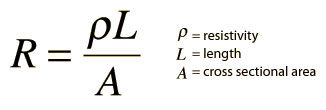Many new speakers these days do not come with speaker wire, leaving the purchaser to try and determine what kind of cable they need for a particular installation. This can be a bewildering task, with different types and gauges of cable all being touted as superior. As well as basic speaker wire, more high-end speaker cables are also available, but since this guide is focused on speaker wire we will not go into more detail on these, but look out for a future discussion on more advanced construction techniques and materials used in more high-end speaker cables.
Speaker Wire Resistance Explained
The key to understanding what makes a superior audio cable for a particular purpose essentially comes down to one main feature: resistance. There are other important considerations; but if your speaker cable doesn't have a low enough resistance, you will not enjoy a good quality of sound.

Lets look at the formula above used to calculate the electrical resistance of a wire. Since resistivity is a constant value for copper at a given temperature and length will remain the same if we are comparing 2 pieces of speaker wire of the same length. Then if we increase the cross-sectional area of the speaker wire we will reduce the resistance.
America Wire Gauge (AWG)
To get a low resistance you need to pay attention to the gauge of the wire that you're using. "Gauge" is a way of talking about the thickness of the wire. Wire gauges are typically given using America Wire Gauge (AWG) measurements; this is a standardized system that has been in use since the 19th century. It's sometimes known as the Brown & Sharpe wire gauge and is used to define the thickness of solid, round, electrically conductive wires. The AWG of a stranded wire (such as speaker wire) is determined by the total cross-sectional area of the wires; because there are small gaps in between the strands, a stranded wire of a particular AWG will be a little fatter than a solid core wire of the same AWG.
The higher the AWG number, the finer the wire. For example: No. 46 AWG wire has a cross-sectional area of 0.0013 mm2 while the cross-sectional area of No. 000000 or -5 AWG wire is 170.5mm2. The relationship between the gauge number and the cross-section of a wire is given a rather complex formula, which need not detain you here.
For speaker cables, the appropriate gauge will usually lie somewhere between 10 AWG and 18 AWG. It's possible to use 22 AWG, but this is really only suitable for very short distances with low powered speakers.
Typical Gauges
Thus, the typical gauges for speaker cable, along with their cross-sectional areas are included below:
| GAUGE | SIZE IN MM2 |
|---|---|
| No. 10 AWG | 5.3 mm2 |
| No. 12 AWG | 3.3 mm2 |
| No. 14 AWG | 2.1 mm2 |
| No. 16 AWG | 1.3 mm2 |
| No. 18 AWG | 0.82 mm2 |
What Gauge to Use
The most important thing to remember is that the lower the gauge number, the thicker the wire, and the lower the electrical resistance. You typically want to reduce the overall electrical resistance as much as possible, which might initially suggest that you always want to choose the thickest wire.
This doesn't necessarily follow if you are trying to save some money however. Over shorter distances - up to 2 - 3 metres, depending on the impedance of your speakers - a smaller gauge wire such as a 18AWG is a sensible choice. Over longer distances, though, you will need progressively thicker cables, otherwise you can begin to lose power to your speakers. While this is unlikely to be severe enough to result in an audible decrease in volume, it can impair the frequency response. There is definitely a large degree of leeway and much will depend on the specifications of your system.
Few Tips For You To Consider When Purchasing Speaker Wire
- If your using reasonable quality home theatre components and speakers don't think it's worth saving a few dollars by buying cheaper / thinner speaker wire as your sound quality could suffer as a result.
- Watch out for other manufactures who attempt to make there speaker wire appear larger by using really think installation around smaller wires, remember to always go by the AWG or cross-section area.
- Remember if your running cables through a wall cavity and or ceiling space the length of wire you require will be a lot longer than the distance from the components to your speakers, so consider running the largest speaker wire you can justify. It's also worth considering that your wiring installation is a time consuming job and you may upgrade the rest of your system in the future to a more high-end system, so remember to design for the future with thicker speaker wire.
- If running speaker wire through a wall cavity choose a decent speaker wire with thick installation to ensure the speaker wire isn't damaged when it's being installed.







